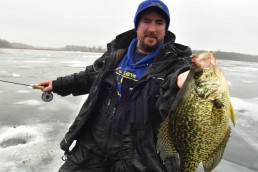Today’s Tools for Ice-Fishing Success
SHARE THIS POST
Takasaki’s takes: tools for ice-fishing success
Ice-fishing has progressed immensely since the early days. Then, poorly dressed anglers began their day by chopping holes with sharp poles called spuds. Now, companies make electronics specifically for the ice. Anglers wear advanced, cold-weather clothing and fish from safe, mobile shelters or vehicles. We now effortlessly drill holes with light, high-powered augers. All of these tools for ice-fishing success have made our time on the ice easier, more comfortable and much more successful.
The very first ice-fishing pioneers often used a “jiggle stick,” which was nothing more than a stick with a nail on the tip that held fishing line. Rod manufacturers now build shorter, highly sensitive graphite rods that hold spinning reels. Anglers can reel fish in just like they were in a boat.
The modern ice angler wears high-tech, waterproof, breathable clothing to keep warm. In addition, new space-age heaters are small and portable enough for modern-day fish houses. Ice-fishing took a giant leap forward with the invention of portable ice shacks made of light, durable material. Anglers transformed into hunters who easily could move from area to area to find fish.
Ice-fishing isn’t all about tech. Sometimes it’s the seemingly simplest things people forget… like keeping quiet.
Electronic advantages
Fish became even easier to find when open-water electronics were adapted to hard-water use. For example, early “flashers” were helping boat-bound anglers find structure to locate fish. It wasn’t long before these same electronics teamed up with small motorcycle batteries and became portable. Ultra-responsive LCD screens now handle cold weather and show fish whether they’re tight to the bottom or just below your hole. Electronics help you determine fish mood by seeing how they react to your jigging action. This allows you to adjust how you work your lure until you find something that triggers a strike.
Today, there are even more tools for ice-fishing success. Advanced sonar units, such as Humminbird’s Ice Helix 7, combine with GPS and lake mapping systems to help anglers quickly dissect big lakes.
Spooning in the weeds for walleyes
Searching for fish through the ice begins with the understanding that fish need to find food now, just like they do in open water. When the ice first forms on natural lakes, ice experts look for shallow water weed beds. Productive weeds can be found 6- to 10-feet down in darker lakes and deeper in clearer water. For walleye fishing, spoons are go-to lures. Snap-jig them and then quiver, lift, and quiver again. Try tipping the spoon with a minnow head. A small 1/32-ounce jig, tipped with a eurolarvae, is perfect for panfish.
Are you enjoying this post?
You can be among the first to get the latest info on where to go, what to use and how to use it!
Mid-lake humps often hold walleyes. The search for structure often took hours in the old days. Now, GPS gives fishermen tools for ice-fishing success, taking them right to the weed beds. GPS technology is actually one of the best advancements for catching fish. Now, anyone can go right to the best spots. Armed with a Lake Master mapping chip, these maps are so accurate that you know exactly where the tips of points and humps are or where you caught them in open water. The most active walleyes are usually found on top of the hump or point. If walleyes are lethargic, they can often lurk on the deeper, transition edge where the hump meets the softer mud basin.
It is now easier to “troll” on the ice by using modern, light, four-stroke power augers or even super-sharp blades that affix to your portable power drill. Drill holes around the tip of a point in a zig-zag pattern. Then, go from hole to hole until you find fish.
Tech for comfort, tech for recon
You can quickly determine what depth of water lies below without even drilling a hole each time. Put a splash of water on the surface of the ice and place your transducer in the water to get a reading. Move often during the day to locate active fish and hang around your best holes during the golden hours around sunset and dawn.
When after walleyes, you often have to put in your time. Comfort keeps you on the ice longer. While today’s portable shelters are great, the ultimate in mobility, comfort, and safety is the Sno Bear ice machine. A Sno Bear is essentially a fish house on tracks and is mobile, even in thick snow. With the push of a button, the Sno Bear lifts or drops to the ice. You fish from the comfort and warmth of your Sno Bear and never have to go outside.
Ice conditions continue to improve. It’s never been easier or more comfortable to ice-fish the modern way.
Check out more from Ted Takasaki, here.
MWO
SHARE THIS POST
Did you enjoy this post?
You can be among the first to get the latest info on where to go, what to use and how to use it!
Ted Takasaki
Ted Takasaki is an International Fishing Hall of Fame professional angler who has been featured in many national outdoor magazines and television shows. Takasaki has appeared in front of thousands of angling enthusiasts and is considered one of America’s top walleye and multispecies anglers. Follow him on his Facebook page.



